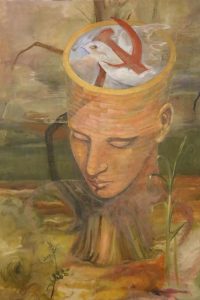The large bronze sculpture three meters high that stands in the garden of Magi museum is a unique example of the link between artistic research and civic involvement, so that it became a symbol of peace and brotherhood internationally known. The section dedicated to this sculpture describes its story and purpose.
The work derives from an oil painting from 1977 by the Italian artist Franco Scepi entitled The man of peace (L’uomo della pace) inspired by Karol Wojtyla, at that time Bishop of Krakow. The expressive and direct power of the image turned it into the anticipatory symbol of the fall of the Berlin wall, and was used first for the poster of the movie The man of marble directed by the polish director Andrzej Wajda and then chosen as a symbol of peace by the Russian politician Michail Gorbacëv, who started the perestroika, a process of radical transformation of the Country. The composition of the image included two versions: the first, close to the original one, where from the head- wall (which has androgynous characters in order to represent the entire humanity) came out the symbols of the hammer and sickle; the second one, later transformed into sculpture with the support of Giulio Bargellini, where from the same face rises up a dove.
The work was placed in the garden of the museum in 2000, in the presence of Michail Gorbacëv and several international authorities. In the same year, together with Gorbacëv, who was awarded the Nobel Prize for Peace in 1990, the image was underwritten by 16 other winner of the Nobel Prize.
Another copy of the sculpture was placed in Rome, near the palace of the FAO, in 2004. Scaled down copies of the monument have been used as prizes for important personalities who have distinguished themselves for their ethical commitment.






